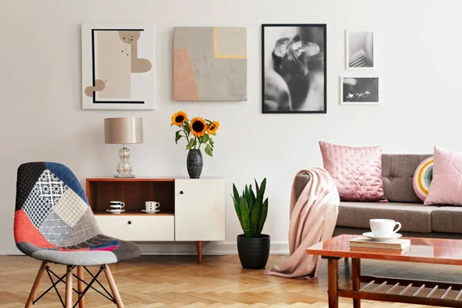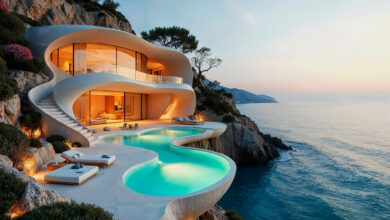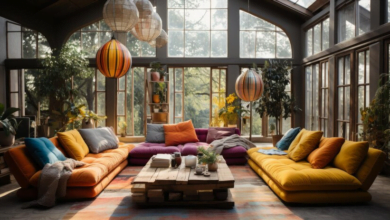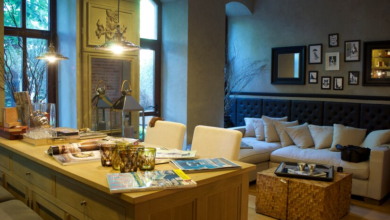Eclectic Design Principles and Tips for Inspired Interiors

Eclectic interiors are the talk of the town, aren’t they? Flip through any magazine, turn on your favorite home improvement TV show, or scroll through a design blog, and you’re bound to stumble upon mesmerizing displays of eclectic design. But the question is, what exactly is eclectic interior design? Let’s find this out. Keep reading to learn about eclectic design principles and more interesting things about this design style that you didn’t know earlier.
What is Eclectic Style?
Rooted in the concept of selectivity, the term “eclecticism” derives from the Greek word eklektikos. This approach to design gained prominence in Europe during the 19th century, particularly in Paris, where the renowned École des Beaux-Arts encouraged a creative environment conducive to innovation and collaboration among students from diverse cultural backgrounds.
Eclectic design became a means for architects to break free from the constraints and rigidity of traditional design trends and styles. As students returned to their respective countries, they brought with them an eclectic ethos, influencing architectural and interior design trends worldwide.
Therefore, eclectic design emerged during a period of cultural exchange and artistic revival. It drew inspiration from various sources, including historical periods, global cultures, and personal preferences, resulting in spaces that celebrate diversity. Today, eclectic design continues to evolve, with variations such as boho eclectic and glam eclectic, each infusing its own unique flair into the eclectic design.

Understanding Eclectic Design Principles
To truly understand eclectic design principles, let’s look deeper into its influences and origins.
1. Cultural Diversity:
Eclecticism thrives on cultural diversity, drawing inspiration from around the globe. From Moroccan textiles to Japanese ceramics, eclectic interiors celebrate the beauty of cultural exchange, infusing spaces with vibrancy.
2. Historical Context:
Going back to history, eclectic design resurrects forgotten treasures and reinterprets classic motifs with a contemporary twist. Whether it’s a Victorian chaise lounge or an Art Deco mirror, each piece tells a story, adding layers of intrigue to the space.
3. Carefully curated design:
Besides a blend of styles, textures, and eras come together to craft a space that feels both curated and spontaneous, cohesive yet delightfully unpredictable.
4. Personal Expression:
This principle is the soul of eclectic design principles. To the untrained eye, eclectic style might seem like a haphazard collection of random items put together. However, this placement of pieces is a form of self-expression. Eclectic style is about surrounding yourself with objects that evoke fond memories, spark conversation, and resonate with your soul.
Practical Tips to Achieve Eclectic Design
Now that we’re familiar with the essence of eclectic design, let’s explore some practical tips for infusing your space with eclectic charm.
1. Select a Cohesive Palette:
Choosing a few core colors to guide your eclectic color scheme is a great starting point. Coherence is key so I recommend opting neutrals for a soft backdrop that ties together disparate elements. You can then introduce accent colors to layer over the space without making it too chaotic or overbearing.
2. Balance Old and New:
Fuse the new and the ancient by juxtaposing vintage pieces with contemporary accents. This juxtaposition is not only visually interesting but also imbues the space with a sense of timelessness.
3. Add Contrast:
Celebrate the beauty of contrast by pairing textures, patterns, and styles that clash yet complement their discordance. Experiment with bold combinations for a distinctive feel and to add drama.
4. Curate with Intention:
Don’t just collect random pieces; get your eclectic space together with intention. Choose items that resonate with you or have a story to tell. For example, display a collection of vintage cameras on a shelf or hang a gallery wall of artwork collected from your travels. These objects can also be a perfect addition to your steampunk home decor.
5. Mix it all up:
Have fun playing with textures and materials to see what fits together and what doesn’t. Combine smooth leather with rough-hewn wood, plush velvet with polished metal, or natural fibers with glossy ceramics for a tactile appearance.
6. Statement Objects:
Choose a bold statement object. Playing with scale, proportions, and colors here can help do the job. Oversized furniture with delicate accents, or vice versa, creates contrast and adds dynamism to the eclectic interior. For instance, place a large statement mirror above a dainty antique vanity to embody the essence of eclectic design principles.
7. Pattern Plays:
Don’t shy away from patterns; instead, embrace them wholeheartedly. Layer different patterns, such as florals, stripes, and geometrics, to keep the eye interested. Just ensure that there’s a common color palette or theme to tie them together so it doesn’t end up looking too messy.
8. Pair Unexpected Elements:
Let’s follow the common philosophy here ‘everything goes’. Surprise and delight visitors by mixing unexpected elements into your eclectic design. Embrace imperfection and asymmetry as part of the charm of eclectic design. This could be anything from quirky artwork to unconventional furniture pieces. For example, hang a vintage bicycle on the wall as a whimsical focal point.
9. Combine Different Furniture Styles:
You will surely get that eclectic vibe by mixing furniture from various styles and periods. Pair a modern sofa with rustic tables or Victorian chairs with minimalist furniture. This fusion adds depth and character to your space.
Conclusion
To conclude our journey through numerous eclectic design principles, one thing becomes abundantly clear: eclecticism is not just a trend; it’s a timeless philosophy. Now we know that eclectic interiors are characterized by their fearless mixing of styles, textures, colors, and eras, creating a balance of old and new, traditional, and contemporary. You are basically mastering a design style that has no rules.
Source: Medium, Decorilla



